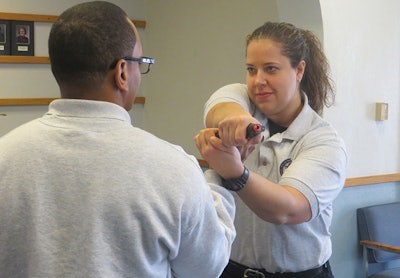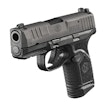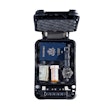 Photo: Michael Schlosser
Photo: Michael Schlosser
At some point in a law enforcement career, you may be faced by an assailant who is pointing a handgun at you. The assailant may have taken your duty weapon from you or produced a handgun of their own. Officers may wonder how they will react if confronted with this situation, which is why training for this critical situation is essential.
Circumstances dictate tactics. Imagine yourself in such a situation. Does the assailant possess your handgun? Their own handgun? What is the assailant's demeanor? What is the assailant saying or not saying? What is the distance between you and the assailant? Is there cover nearby? Do you have a backup gun?
Depending on these circumstances, your tactical choices may include: immediately attempting to disarm the assailant, talking to the subject using de-escalation techniques, attempting to disarm the assailant while talking to them, retrieving your service weapon or backup handgun (if the assailant possesses your handgun), or retreating.
If you decide to reason with the assailant, the assailant may hesitate to shoot. The best time to disarm an assailant during that conversation—should you decide to attempt a disarming technique—is when the assailant gives you a command. For example, if the assailant says, "Back up," or "Get your hands up higher," the assailant then expects movement from you. That makes this the best time for you to react with a disarming technique.
There are several disarming techniques. I will describe three.
If the assailant is in front of you and pointing a handgun at you, the assailant will likely expect you to become submissive, perhaps by putting your hands up. Though you can maintain a submissive appearance, you should keep your hands facing the assailant while staying within your silhouette. If your hands are kept within your own silhouette, any disarming technique requires much less distance to the handgun. The least amount of movement required will give the assailant less time to react.
Horizontal Twist Technique
For the horizontal twist technique, you can bring one hand to the front of the weapon while moving the other to its rear, turning the handgun toward the assailant and maintaining a good grip. Importantly, this must be one simultaneous movement, with your forearms crossing. This twisting motion will weaken or dislodge the assailant's grip on the handgun.
If this movement alone does not cause the assailant to release the handgun, you should create a strong base by lowering your center of gravity and widening your stance. Then quickly and forcefully pull the handgun away from the assailant toward the center of your abdomen, using the muscles in your back and biceps. This technique has the advantage of comprising just one simple movement, regardless of how or in what hand(s) the assailant is holding onto the weapon. While learning this technique, you can decide which hand feels more comfortable grabbing the front of the handgun and which hand feels more comfortable going to its rear.
Vertical Twist Technique
The vertical twist technique can be done in two different ways. If the assailant is holding the weapon in their right hand, you can grab the gun with your left hand while stepping off line to the left. Your left hand should then strongly hold the assailant's wrist and arm in place. With the right hand, rotate the gun backward, directly toward the assailant's wrist. The key to this movement is to rotate the gun in a tight circular motion, quickly and forcefully.
Conversely, if the assailant is holding the weapon in their left hand, you should grab the gun with your right hand while stepping off line to the right. Using your left hand, you should, again, rotate the gun backward, directly toward the assailant's wrist, in a tight circular motion.
Arm Lock Technique
If the assailant is behind you and pointing the weapon at your back, a good option is the arm lock technique. You can rotate your body backward and closer to the assailant, while moving off line from the handgun. Your inside arm should rotate over the assailant's arm, locking it tightly at the elbow to prevent it from moving. Once the arm is locked, attack the assailant with head strikes, continuing to turn until facing away and grabbing hold of the handgun with both hands. Then twist the weapon from the assailant's hand. If the gun is not yet released from the assailant's hand, to release the handgun you will need to then quickly and forcefully move your hips back while simultaneously pushing the weapon forward.
After Disarming the Assailant
Once you've disarmed the assailant, create distance, give commands to the assailant, and assess the threat. You can create distance by pushing, striking, and/or retreating. If you have recovered your own weapon during the struggle, you should "tap/smack" to make sure the magazine is seated properly, and "rack" in case any brass is hung up in the ejection port, and get a fresh round into battery. If you have taken away the assailant's weapon, you should now draw your service weapon.
Keep Your Options Open
There is never a foolproof technique to disarm a subject with a gun. Options include immediately disarming the assailant, waiting for the right moment, using de-escalation communication, getting to another weapon, and even retreating. Your best option will depend on the situation.
As with all skills, it is important for officers to train and practice often. You can never have enough repetitions of any skill or technique. As the saying goes, amateurs practice until they get it right; professionals practice until they cannot get it wrong.
Dr. Michael Schlosser, Ph.D., is the director of the University of Illinois Police Training Institute, and the Institute's lead control and arrest tactics instructor. He retired from the Rantoul (IL) Police Department as a lieutenant.











